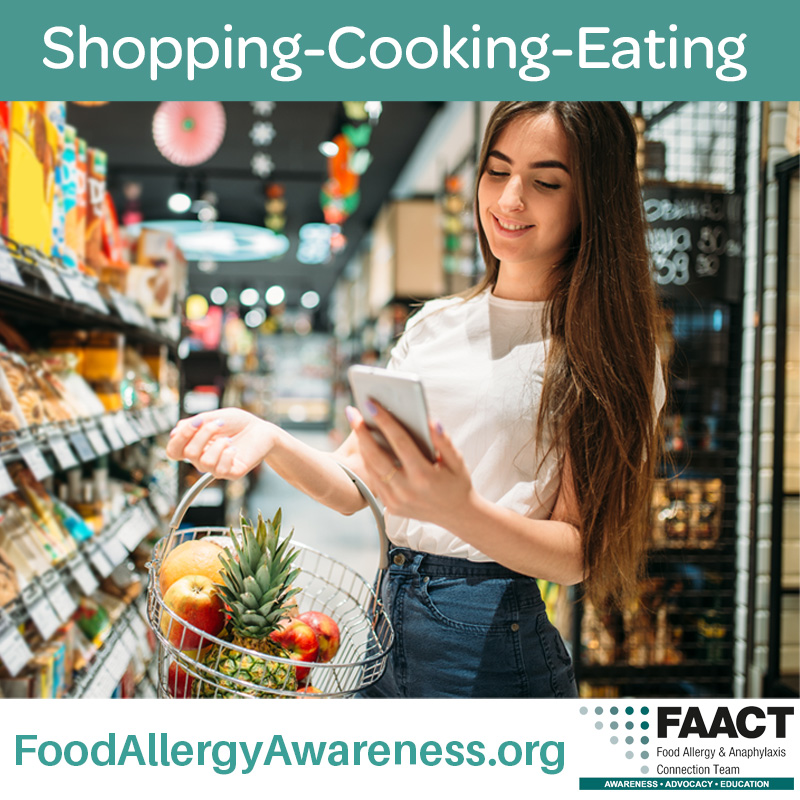Education
Adults with Food Allergies
Back to Category View
Shopping, Cooking, and Eating with Food Allergies
Moving or living on your own can be exciting – and a little nerve-racking as food allergy responsibilities shift and put you in control of cooking and entertaining. Let us help you get comfortable with your new kitchen by offering a few tips.
Shopping
- Learn how to read product labels, including “hidden” terms used for certain allergens.
- You will generally want to avoid the bulk foods aisle and salad or hot food bars where cross-contact can occur.
- No label, do not purchase or eat!
- Get comfortable calling a manufacturer to confirm ingredients and cross-contact risk with your allergen, particularly if foods have generic ingredient lists such as “spices.”
- Understand that labels are not complete. Precautionary labeling – such as “may contain,” “made on shared lines,” or “made in the same facility as” – are VOLUNTARY. A manufacturer does not have to label for potential allergen risk if allergens are not an actual ingredient in that product.
- Manufacturers are only required to label packaged food products for the top eight allergens: peanut, tree nut, wheat, soy, egg, milk, fish, shellfish, and sesame.
- As of January 1, 2023, sesame was added as the top 9th allergen and is required to be plainly labeled on all packaged foods.
- U.S. Food and Drug Administration rules on allergen labeling do not include alcohol products or personal care products, both of which can contain common food allergens.
- Be wary of packaged foods sold at farmer’s markets, local shops, or other small producers who may use shared kitchens to create small-batch products. Ask about allergens in the foods as well as potential cross-contact. Fresh product is a safer purchase at a farmer’s market than something like baked goods.
Cooking
- Confirm your house rules for allergens: Are they allowed in the house? In the kitchen? How will you keep your food and ingredients separate?
- Consider maintaining an allergen-free shelf in the refrigerator and pantry if that is adequate for your needs.
- Don’t be afraid to ask for what you need, but be up front about it before you enter into a shared housing situation with friends. If your friend has a life-long love of PB&Js and you need them to keep peanut butter out of the house, that’s something that should be discussed before you sign a lease together.
- Consider how you will manage microwaves, toasters, and other shared appliances. Will these be exposed to roommates’ foods that contain allergens? Will you need to have a personal toaster, microwave, and other appliances to prevent cross-contact?
- Visit FAACT’s Pinterest Page to find Allergy-Friendly Recipes, Cultural Allergy Friendly Recipes, and the Kid’s with Food Allergies Safe Eats Allergen-Friendly Recipe database.
- Always do your research for safe ingredients, read labels, and call manufacturers if needed.
Eating
- If someone else is cooking for you, ask about food preparation and cross-contact. Ask to read the ingredient labels for every item used in meal preparation (including condiments and sauces).
- Make sure you feel comfortable that the person cooking for you can keep you safe. If not, bring your own food or a dish to share, and bring your own serving utensils.
- If it’s not inconvenient for your host, one approach to consider is helping with food preparation so you can read labels and prevent cross-contact as you go. (It can also be fun to cook together!)
- Carry allergen-safe energy bars, alternate nut or seed butters and crackers, and other satiating foods when you are away from home. Keep them stocked in your backpack/purse or other bag that you use when you leave the house.
- Keep a list of allergen-friendly restaurants and eateries handy for suggestions when a group of friends wants to eat out.
- When in doubt, don’t eat it!
- Even if you’re not planning to actually eat at a friend’s house or a restaurant, you can still be exposed to allergens. Be sure to carry two epinephrine auto-injectors and your Allergy & Anaphylaxis Emergency Plan when you leave the house.